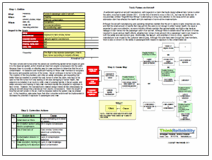A settlement against an aircraft manufacturer, with regards to a claim that faulty design allowed toxic fumes to enter the cabin, occurred in early October 2011. It is the first of its kind to occur in the U.S., but may not be the last. A documentary entitled “Angel Without Wings” is attempting to bring more attention to the issue, which air safety advocates claim has affected the health and job-readiness of some airline crewmembers.
Although the aircraft manufacturing and operating industries maintain that the air in cabins is safe, breaches are rare, and that the small amount of toxicity that may get into the cabin is not enough to affect human health, the issue is expected to gain more attention, as some industry officials maintain that approximately one flight a day involves leakage of toxic fumes into the passenger cabin of an aircraft. Although there is debate about the amount of fumes required to cause various health effects, allowing toxic fumes of any amount into a passenger cabin is an impact to both the safety and environment goal. Additionally, the lawsuit – and the potential of more to come – against the manufacturer is an impact to the customer service goal. Although the suits have been brought by crew members, there is also a concern for the safety of passengers with respect to exposure to the contaminated air.
 The toxic smoke and fumes enter the plane’s air conditioning system when engine air gets into the bleed-air system, which directs air bled from engine compressors into the cabin. Because there is currently no effective way for crew members to determine that the air is contaminated – no detectors and insufficient training for these crew members to recognize the source and possible outcome of the fumes – the air continues to be fed to the cabin. The creators of the documentary, and other air safety advocates, are requesting that better filters be installed to prevent the toxic fumes to enter the cabin, less toxic oil be used so that the fumes from any leaking oil are less damaging to human health, that detectors be installed in air ducts to notify crew of potential toxicity in the air supply, and better education and training to help crew members identify the potential for exposure to toxic fumes. However, the manufacturer’s newest design makes all this unnecessary by using an aircraft design that provides air from electric compressors. Given the length of time that aircraft remain in the air, it will be decades before the system may be phased out. In the meantime, advocates hope that other corrective actions will be implemented to decrease the potential of exposure to passengers and crew.
The toxic smoke and fumes enter the plane’s air conditioning system when engine air gets into the bleed-air system, which directs air bled from engine compressors into the cabin. Because there is currently no effective way for crew members to determine that the air is contaminated – no detectors and insufficient training for these crew members to recognize the source and possible outcome of the fumes – the air continues to be fed to the cabin. The creators of the documentary, and other air safety advocates, are requesting that better filters be installed to prevent the toxic fumes to enter the cabin, less toxic oil be used so that the fumes from any leaking oil are less damaging to human health, that detectors be installed in air ducts to notify crew of potential toxicity in the air supply, and better education and training to help crew members identify the potential for exposure to toxic fumes. However, the manufacturer’s newest design makes all this unnecessary by using an aircraft design that provides air from electric compressors. Given the length of time that aircraft remain in the air, it will be decades before the system may be phased out. In the meantime, advocates hope that other corrective actions will be implemented to decrease the potential of exposure to passengers and crew.
To view the Outline and Cause Map, please click “Download PDF” above. Or click here to read more.

